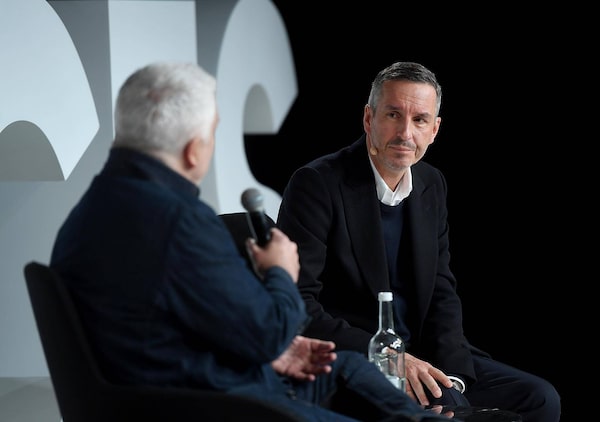
Dries Van Noten, right, speaks to Tim Blanks during Business of Fashion 2017’s Voices event.Samir Hussein
Considered a quiet maestro who has captivated fashion lovers for decades, Dries Van Noten stepped out from behind the proverbial curtain several times in the past year, with an eponymous documentary recently added to Netflix and a two-volume tome, edited by Tim Blanks, about his women and men's wear brands' 100-collection history. Van Noten, known for his artful garments and accessories that speak to craft traditions and a high attention to detail, spoke with Blanks at the annual Business of Fashion conference, Voices, this past December. It was another opportunity for the audience (both in situ and via livestream) to get a glimpse into the mind behind one of the industry's independently run labels. He also used the occasion to speak to The Globe and Mail about his influences, fast fashion and why beautiful clothing makes for a great escape.
Why did you participate in Voices?
It's something which shows fashion in a bigger way. You have the whole business side of fashion, but fashion is also such a socially important thing. Clothes for me are really a way of communication and that's the way that I design. For me, it's an ideal moment to hear what a lot of people have to say and to not only speak, but to listen.
Your influences range from folklore to Frank Zappa. Can you tell me about your design process?
I always try to create things where there's a good balance. For me, balance is very important. As you know, I love fashion but I also love gardening. On one side, fashion makes you great but then gardening makes you humble – you're really with your two feet on the ground. Those are things that I need. And the collections that I make, on one side I try to look back to the past, to respect the past and tradition and the savoir-faire and the skills. But it's not that I'm nostalgic; I just take some elements of the past and also look to the future, and look to now. To create clothing that people can wear now. It makes no sense to create wardrobes that would be good maybe to play in a movie from the sixties. People are living now, they need clothes to wear now. That's very important.
What's been the biggest change or most surprising thing that you've noticed since the beginning of your career until now?
Every year there's a change. The arrival of the internet of course makes a huge difference, but that's the nice thing about being in fashion. You have to watch very carefully what's happening in the world. What you do has to reflect the way people feel – what people need as kind of a feeling via the clothes. If they put on a black coat, it's one feeling, and if they put on an embroidered top, [they] want to tell something else. You always have to have a connection with what's happening in the world. Also, I said with the last collection, there are such strange things happening in the world at the moment, that for me, this collection was more about escapism.
You don't seem interested in saying, "This celebrity wore our clothes." Your social-media platforms are more about the details and the process. Why do you manage your brand that way?
That's what interests me. It's about the skills, the weavers – the making of certain things is more important to me than a certain celebrity, who often has been paid to wear a certain outfit. We have a lot of celebrities who wear our clothes but the nice thing is they buy them and they're in our stores.
There are many designers who've done collaborations with mass brands – is that something you would ever see yourself doing?
No. I want there to be a clear difference between what my fashion is and high street fashion. I think to blur that line is only in the interest of fast fashion, which is not really my enemy, but I want people to understand that when we ask for a certain price for a certain garment, there's a reason for that. And I want to be honest about the prices, what we do. In our collection, we have T-shirts at a low price, and we have embroidered coats, which take hours and hours of embroidery, which cost a fortune.
Visit tgam.ca/newsletters to sign up for the Globe Style e-newsletter, your weekly digital guide to the players and trends influencing fashion, design and entertaining, plus shopping tips and inspiration for living well. And follow Globe Style on Instagram @globestyle.